Posted by Mike Cunningham on May 26th 2023
What is compostable packaging?
Compostable Packaging: Reducing impact on the environment is high on the agenda of millions of businesses – large and small. And well designed, sustainable packaging is a great way to lower your carbon footprint. When it comes to eco-friendly packaging materials, one of the most common requests that we hear is for compostable packaging.
On the surface, compostable packaging sounds great – but it’s important to understand what compostable packaging is, how it differs from other sustainable packing materials and acknowledge that not all compostable packaging is made equal.
What is compostable packaging? Compostable packaging is a type of packaging material that can be disposed of in a responsible way and adheres to the principle of circular economy. Compostable packaging products are made from materials that decompose fully into compost without producing toxic residue as they break down.
The difference between compostable and biodegradable packaging. There is a common misconception that compostable and biodegradable packaging are interchangeable. In fact, they are not the same.
If something is biodegradable, it simply means it will decompose with the help of bacteria or other living organisms over time. Theoretically, all things will decompose eventually, but some may take thousands of years to do so! Biodegradable products also require specific conditions to break down properly and may produce harmful greenhouse gas emissions if left to decompose in landfill. Therefore, although the decomposition process occurs naturally, it can still be harmful to the environment. In contrast, compostable products disintegrate without harming the environment, turning into soil enriching compost instead.
So, how can packaging reduce your businesses’ impact on the environment? Here we look at several factors – it’s role in the circular economy if it can be recycled and the benefits and challenges associated with using this type of packaging.
Compostable packaging and contributing to the circular economy. For many, compostable packaging is a step in the right direction in terms of packaging and the environment. However, it is worth noting that compostable packaging is still single use.
When used appropriately, it is another weapon in the packaging industry’s arsenal to prevent waste and regenerate nature but long-term, infrastructure to support organic material collection and repurposing will be key to make compostable packaging a success. Therefore, businesses must ask themselves if compostable packaging is right for their packaging strategy and make an informed decision whether they should first look at material reduction or reuse.
Is compostable packaging recyclable? This all depends on the type of compostable packaging you are using. For example, some compostable and biodegradable materials, such as cardboard, can be recycled. Compostable plastics, however, are not designed to be placed into the mixed recycling bin, due to the differences in decomposing processes.
Most recycling plants are not equipped to deal with compostable plastics and placing them into mixed recycling could simply lead to potential contamination. They will have to be placed into your general waste bins instead.
Benefits of using compostable packaging. Switching to compostable packaging can help reduce your environmental impact and carbon footprint. Compostable packaging takes less time to break down in landfills and does not produce harmful substances in the process. It can enhance soil quality and, as it’s made from organic materials, requires fewer sources to be produced. Compostable packaging can also help improve your brand image and show that your company cares for the environment – but it must be used appropriately and labelled properly.
Challenges of using compostable packaging. While there are benefits of using compostable packaging, there are potential challenges too. Packaging labelled as “compostable” is not always suitable for home-composting. It is important to check the labels to make sure the packaging is disposed of correctly to avoid cross-contamination. This is something that businesses need to factor in.
Compostable plastics cannot be placed into the recycling bin as they require the correct decomposing conditions to fully disintegrate. Compostable packaging can also be more expensive, however, as demand for it grows, there is a potential for it to become less pricey. If designed correctly and used in an appropriate application, it can also save you costs in the long run, but businesses should balance the swap against if reducing material use or returnable packaging options could have better environmental impact for their operation.
When considering plant-based bioplastics, case should be taken to understand how that plastic is being created and the environmental consequences around land use, agriculture and transport relative to the alternative. There are some exciting innovations in the compostable packaging area, and it is the one to watch, as it’s likely to continue to evolve! One example is the seaweed packaging that won the Earth Shot prize with packaging that is completely natural and harvested in an environmentally friendly way from seaweed.
This has good applications currently for primary packaging but is not yet on the scale to offer viable secondary packaging solutions.

